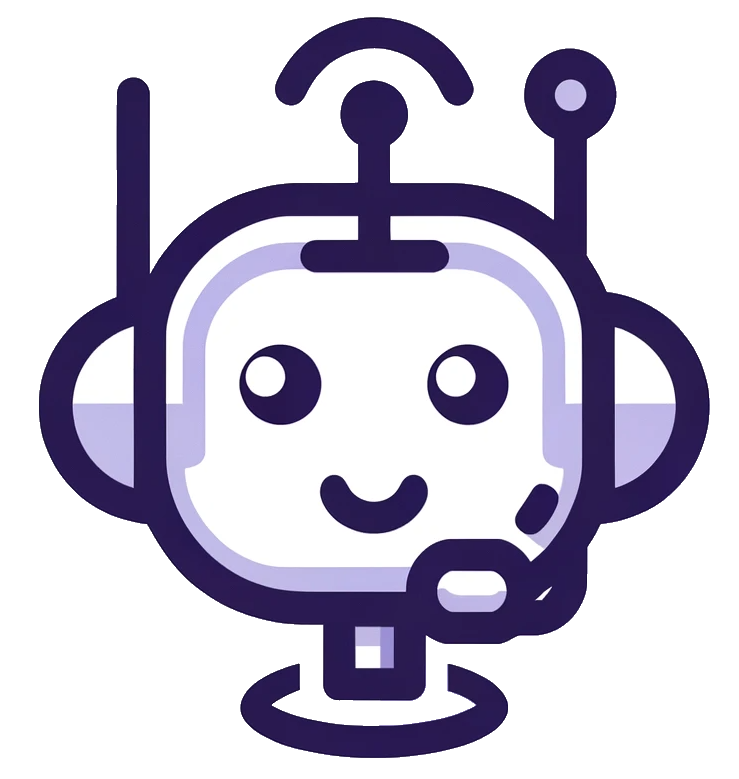Our Chatbots combine rules and AIare individually craftedare state-of-the-artcan have huge knowledgebases!
industry-leading chatbot solutions for every business.
We are a full-service agency specialized in delivering profitable chatbots to companies worldwide – to increase customer satisfaction, lead and sale generation as well as for internal process optimization.
We use the latest technology to deliver all kinds of chatbots. depending on your business and the goals for the bot:
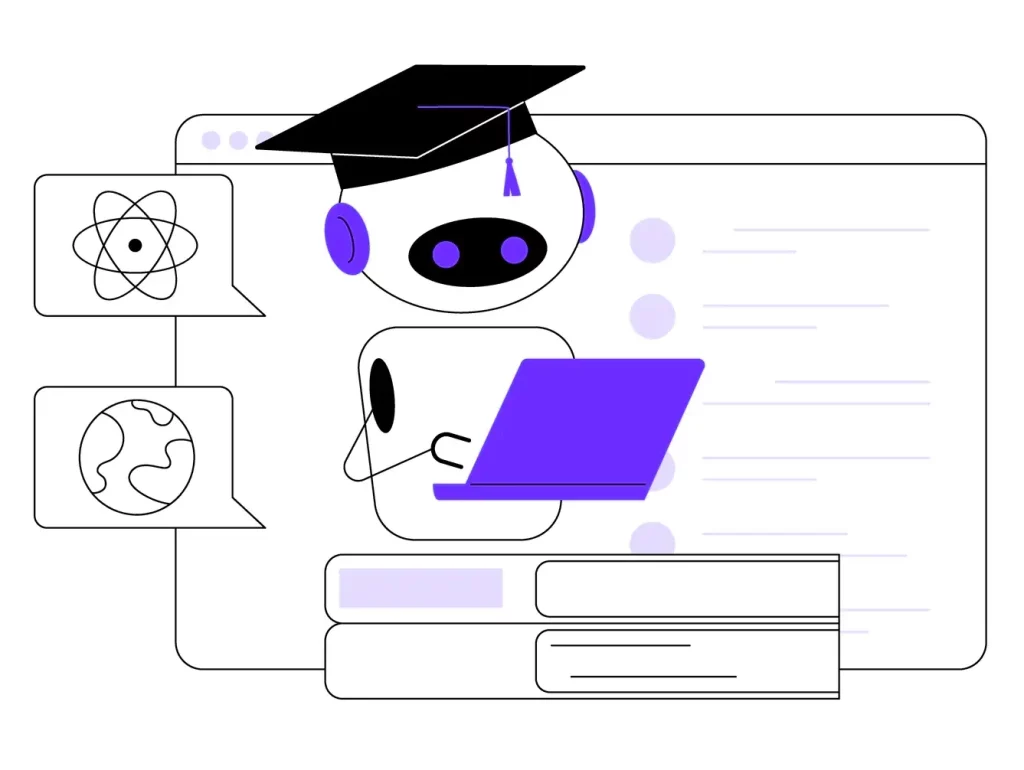
What are chatbots for?
Chatbots, acting as digital companions, are ever-ready to engage and assist users, providing a seamless interface for them to interact at any hour of the day. They are invaluable to businesses as they significantly enhance customer service by providing instant responses to customer inquiries, and help in reducing operational costs by automating routine tasks, thus allowing human employees to focus on more strategic aspects of the business. Moreover, their ability to handle multiple interactions simultaneously ensures a consistent level of service even during peak times, making them a reliable and cost-effective solution for modern businesses.
Three main chatbot types: Rule-based, AI-based and Hybrid
They come in three types: rule-based, AI-based, and hybrid. Rule-based chatbots follow set rules to answer questions, making them good for straightforward queries but less adept at handling complex ones. AI-based chatbots use advanced technology to understand and respond more naturally, improving with each interaction and using own knowledgebases. Hybrid chatbots combine both approaches: they use rules for simple queries and advanced technology for more complex discussions based on own knowledgebases and large language models (such as chatgpt) as a backup. This combination enables them to provide reliable answers, understand users better, and continuously learn to improve, making them a versatile choice for various conversational needs.
Rule-based chatbotGuide the user with simple clicks and rules according to input
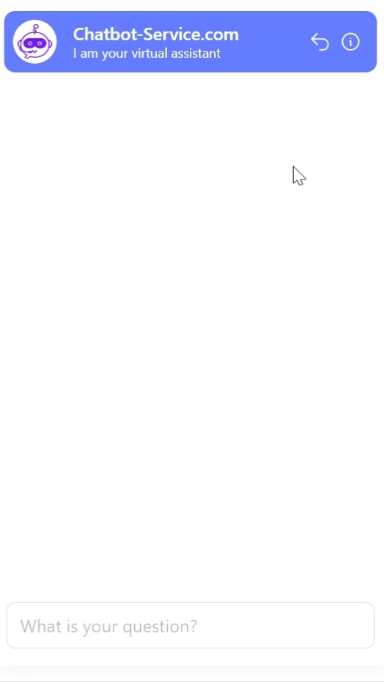
In short: Rule-based chatbots respond to user queries by following predefined (strict) rules and decision trees, making them effective for handling straightforward and structured interactions.
Technical construction: fixed text-rules according to a predefined decision tree with some smart bot reactions.
Examples
Input: “What’s the minimum wage?”
- Output: “The minimum wage varies by state. Please provide the name of your state for accurate information.”
Input: “How to contact a lawyer?”
- Output: “You can contact a lawyer by calling our office at [Phone Number] or by filling out the contact form on our website.”
Input: “Can I book a consultation?”
- Output: “Yes, to book a consultation, please call us at [Phone Number] or fill out our online form [link].”
Input: “What do you do about workplace discrimination?”
- Output: “We offer legal advice and representation for cases of workplace discrimination. You can schedule a consultation for personalized assistance.”
Input: “Where are you located?”
- Output: “We are located at [Address]. We are open from [Opening Hour] to [Closing Hour], Monday through Friday.”
Use cases
- Menu Navigation: Assisting users in navigating through digital menus to find the information or service they need.
- FAQ Support: Providing immediate answers to frequently asked questions on a company’s website.
- Form Submission: Assisting users in booking, modifying, or canceling appointments.
- Product Finder: Helping users find products based on specific criteria like size, color, or brand.
- Basic Troubleshooting: Guiding users through basic troubleshooting steps for common issues.
- Resource Locator: Helping users find resources or locations, like the nearest store or ATM.
- Business Hours Information: Providing information on business hours, holidays, and other time-related inquiries.
Advantages
- Predictability: Rule-based chatbots follow predefined rules, ensuring consistent and predictable responses.
- Ease of Implementation: They are generally easier and quicker to implement as compared to AI-based chatbots.
- Cost-Effectiveness: Lower development and maintenance costs compared to more complex AI-driven chatbots.
- Transparent Logic: The decision logic is transparent and easy to understand, making troubleshooting simpler.
- Compliance and Control: Easier to ensure compliance with legal and business standards due to their predictable behavior.
- Low Error Rate: For the tasks they are designed for, they have a low error rate as they follow a set script.
- Structured Interaction: They provide a structured interaction flow, which can be beneficial for guiding users through specific processes or forms.
- Data Collection: Effective in scenarios where structured data collection from users is required.
- Ease of Integration: They can be easily integrated into existing systems due to their straightforward functionality.
- Defined Boundaries: They operate within well-defined boundaries, ensuring controlled interactions with users.
Disadvantages
- Limited Understanding: Rule-based chatbots lack the ability to understand natural language, which can lead to misunderstandings or ineffective interactions.
- Rigid Interaction Flow: They follow a rigid, predetermined interaction flow that can be frustrating for users seeking more conversational or complex interactions.
- No Learning Capability: Unlike AI-based chatbots, they do not have the ability to learn from user interactions and improve over time.
- Difficulty with Complex Queries: They struggle to handle complex or nuanced queries that fall outside their predefined rules.
- Manual Updating Required: Any changes in information or process require manual updates to the rule set.
- Limited Scalability: Their functionality is hard to scale or adapt as business needs evolve.
- Dependency on Clear Instructions: They require clear and precise user input to function correctly, which can be a hindrance in user-friendly experiences.
- Lack of Personalization: Rule-based chatbots generally lack the ability to offer personalized interactions or responses.
- Potential for Repetitive Responses: They may provide repetitive or overly mechanical responses, which can be off-putting for users.
- Inability to Handle Ambiguity: They are unable to handle ambiguous or unclear inputs effectively, often requiring users to rephrase or clarify their requests.
Steps to build
1. Requirement Analysis:
- Understand the chatbot’s goals and scope.
- Identify the industry, target audience and their needs.
2. Design and Rule Definition:
- Develop a dialogue flow with greetings, responses, and farewells.
- Set keyword-based rules and use regular expressions for user input recognition.
- Utilize predefined choices / buttons for quick replies or external links
- Plan fallback strategies for unrecognized inputs.
3. Testing and Deployment:
- Conduct functionality testing to ensure the chatbot operates as intended.
- Connect with any necessary third-party services for data exchanges (APIs).
- Style the chatbot in company CI with avatar, colors and greetings
- Deploy the chatbot on the intended platforms once it passes all testing phases.
4. Monitoring and Maintenance:
- Monitor the chatbot’s performance and analyze user feedback.
- Make necessary updates based on feedback and performance analysis.
AI-based chatbotLet the chatbot react smart according to own knowledgebases and with gpt4.0 fallback
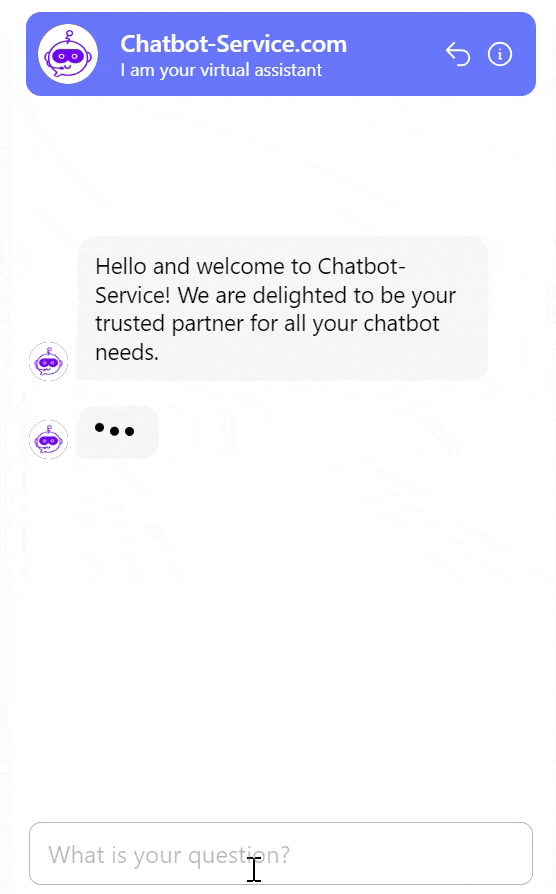
In short: AI-driven chatbots interpret and respond to user queries by leveraging machine learning and natural language processing (NLP) technologies, enabling them to handle unstructured, nuanced, and complex interactions on individual knowledgebases.
Technical construction: AI answering according to an individually trainined knowledgebase for sophisticated answering and (optionally) gpt4.0 as a fallback
Examples
Input: “What’s the minimum wage?”
- Output: “The minimum wage can differ based on your location. Could you tell me which state you are inquiring about so I can provide precise information?”
- Hint: The chatbot will pull the minimum wage data from the knowledge base once the state is provided by the user.
Input: “How to contact a lawyer?”
- Output: “You can get in touch with a lawyer either by giving us a call at [Phone Number] or by completing the contact form on our website. Which option works best for you?”
- Hint: The phone number and the contact form link are retrieved from the knowledge base by data from the website.
Input: “What do you do about workplace discrimination?”
- Output: “We provide legal counsel and representation for workplace discrimination cases. Would you like to schedule a consultation to discuss your situation in detail?”
- Hint: The information regarding legal counsel and representation for workplace discrimination is retrieved from the knowledge base by data from a pdf.
Input: “Tell me about recent changes in employment law?”
- Output: “I’m sorry, I don’t have the most recent updates in my training data. Would you like me to provide a web-search about the recent changes in employment law?”
- Hint: As the knowledge base doesn’t have this information, GPT-4.0 with websearch is utilized to offer a fallback response.
Use cases
- Contextual Website Navigation: Assisting users in navigating through websites by understanding their natural language queries, and providing details on products or services from the website, also based on previous interactions or user preferences, enhancing user experience.
- Dynamic FAQ Support: Providing immediate and personalized answers to frequently asked questions on a company’s website, while also learning from user interactions to continuously update the knowledge base for more accurate responses.
- Summarization and Extraction: Summarizing or extracting specific aspects of a vast service- or product portfolio and making it fit to customer needs and inquiries.
- Intelligent Form Submission: Assisting users in booking, modifying, or canceling appointments by understanding complex or vague requests, and asking clarifying questions to ensure accurate service. (connections to third party services are necessary)
- Advanced Product Finder: Helping users find products based on specific criteria by understanding nuanced requests, and suggesting alternative or additional products based on a knowledgebase of all products, user preferences and buying history.
- Proactive Troubleshooting: Guiding users through troubleshooting steps by understanding the issues described in natural language, and offering solutions from the knowledge base or suggesting resources for further assistance if an issue is not resolved.
- Update on Recent Changes or Events: If a user inquires about recent changes in policies or upcoming events which are not integrated in the knowledge base, the chatbot can use GPT-4.0 including web-search to provide an informative response or suggest contacting a human representative for the latest updates.
Advantages
- Adaptive Learning: AI chatbots learn from user interactions to improve responses and provide more accurate information over time, which is further enhanced with a rich knowledge base.
- Natural Language Understanding (NLU): Capable of understanding and processing natural language inputs, providing a more human-like and interactive conversation experience.
- Dynamic Interaction: They offer dynamic and personalized interactions, understanding nuanced requests, and providing tailored responses.
- Comprehensive Knowledge Retrieval: With a well-structured knowledge base, AI chatbots can provide detailed and precise information on a wide array of topics, providing a one-stop solution for user inquiries about a company, its website etc.
- Fallback to ChatGPT: In instances where the knowledge base may not have certain information, the ChatGPT fallback ensures that the user still receives a meaningful response.
- Cost Efficiency Over Time: While initial setup might be costly, over time, the reduced need for human intervention and the ability to handle a high volume of queries leads to immense cost savings, especially at scale.
- Enhanced User Satisfaction: By providing accurate, personalized, and instant responses, they significantly enhance user satisfaction.
- Further Automation by third party integration: When integrated with e.g. a CRM system, an AI chatbot can fetch and update customer data, helping businesses to provide personalized services or responses to their customers in real-time.
- Unstructured Data Handling: Unlike rule-based chatbots, AI chatbots can handle unstructured data, providing more flexibility in user interactions.
- Continuous Improvement: Continuous learning from user interactions and feedback allows for ongoing improvement, ensuring the chatbot remains a valuable asset over time.
- Integration Capabilities: Although more complex, they can be integrated into existing systems, leveraging APIs and other integration tools to provide a seamless user experience.
Disadvantages
- High Costs: The initial setup, including the development of a robust knowledge base and integration of AI and GPT-4.0 technologies, can be costly in terms of initial cost as well as usage costs
- Complex Implementation: Implementing an AI-based chatbot can be complex and time-consuming
- Maintenance: Continuous maintenance and updates to the knowledge base are required to ensure the chatbot remains accurate and relevant
- Dependency on Data: The effectiveness of AI-based chatbots largely depends on the quality and quantity of data available for training and updating the knowledge base.
- Potential Privacy Concerns: Handling sensitive or personal information can raise privacy concerns, especially when utilizing external AI services like GPT-4.0.
- Limited Understanding: Despite advancements, AI chatbots may still struggle with complex or nuanced user queries, and may require a fallback to human support.
- Error Handling: Errors made by AI chatbots can sometimes be difficult to troubleshoot due to the complexity of AI algorithms.
- Compliance Challenges: Ensuring compliance with legal and business standards can be challenging, especially when the chatbot is learning and evolving from user interactions.
- Resource Intensive: AI chatbots can be resource-intensive, requiring substantial computational power and storage, especially when utilizing advanced AI services like GPT-4.0.
- Training Limitations: There might be limitations in training the chatbot to understand specific industry jargon or highly specialized topics without a well-curated knowledge base.
Steps to build
Requirement Analysis:
- Understand the chatbot’s goals and scope.
- Identify the industry, target audience, and their needs.
- Develop a chatbot personality (short or detailed answers, tone, goals of the interaction with the user etc.)
Design and Rule Definition:
- Develop a dialogue flow with greetings, responses, and farewells.
- Employ machine learning and natural language processing (NLP) for user input recognition with the help of LLMs such as gpt4.0
- Incorporate a business-specific knowledge base with uploading information from webpages, docs, pdfs, etc. to provide accurate information.
- Plan fallback strategies for unrecognized inputs or not possible answers from the knowledgebase and – as an option – let gpt4.0 answer with the knowledge of the whole internet.
- Design and implement data interactions with third-party services such as CRM or event or booking providers
Testing and Deployment:
- Conduct functionality testing to ensure the chatbot operates as intended.
- Style the chatbot in company CI with avatar, colors, and greetings.
- Deploy the chatbot on the intended platforms once it passes all testing phases.
Monitoring and Maintenance:
- Monitor the chatbot’s performance and analyze user feedback.
- Make necessary chatbot personality and knowledge base updates based on feedback and performance analysis.
- Utilize the learning capabilities of AI to improve chatbot responses over time.
Hybrid chatbot (Rules + AI)Rule-based reactions with AI driven answers for complex inquiries with own knowledgebase and gpt4.0 fallback
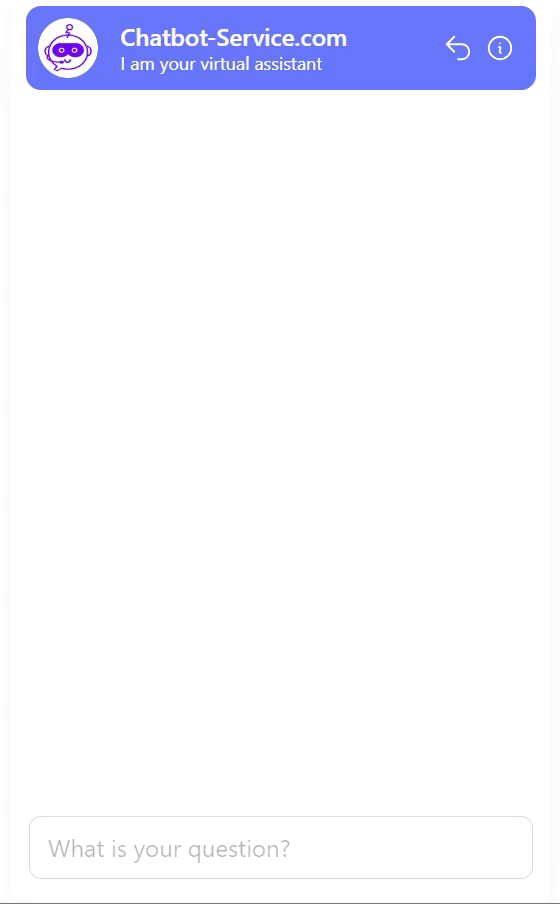
In short: Hybrid chatbots merge rule-based in- and outputs with interpreting and responding to user queries by leveraging machine learning and natural language processing (NLP) technologies, enabling them to handle unstructured, nuanced, and complex interactions.
With the option to integrate individual knowledgebases, where bot reactions are based on first with chatgpt and websearch fallback, these bots are incredibly capable to engage with users with sophisticated answerings.
Technical construction: Fixed rules for easy customer interaction, combined with AI answering based on an individually trainined knowledgebase with (optional) chatgpt with websearch as a fallback
Examples
Input: “How to contact a lawyer?”
- Rule-based Output: The user is provided with a predefinied answer “You can contact us through different ways”. Then the user is presented with two buttons, 1) phone number (with tel link) and 2) the contact form (link to webform)
- AI Output (alternatively): “You can get in touch with a lawyer either by giving us a call at [Phone Number] or by completing the contact form on our website. Which option works best for you?” Based in the input of the user, the link to the contact form or phone number is provided
- Hint: in this cas, a rule-based approach is more compact and accurate, and the output can be triggered by the word “contact”. However, a conversation style (done only with AI) sometimes offers more customer satisfaction.
Input: “What do you do about workplace discrimination?”
- AI Output: “We provide legal counsel and representation for workplace discrimination cases. Would you like to schedule a consultation to discuss your situation in detail?”
- Hint: The information regarding legal counsel and representation for workplace discrimination is retrieved by AI from the knowledge base by data from a pdf. It does not make sense to define rules and text outputs for all possible keywords such as “workplace discrimination”.
Input: “Tell me about recent changes in employment law?”
- AI Output: “I’m sorry, I don’t have the most recent updates in my training data. Would you like me to provide a web-search about the recent changes in employment law?”
- Hint: As the knowledge base doesn’t have this information, GPT-4.0 with websearch is utilized to offer a fallback response. As in the example before, rules do not make sense in this case.
Use cases
- Tiered Customer Service: For basic queries, the chatbot can immediately provide a rule-based answer, ensuring fast response times. If the query is more complex or requires nuanced understanding, the AI component can step in to handle it.
- Regulatory Compliance: In industries like banking or healthcare, certain responses need to be consistent and adhere to regulations. The rule-based part of the chatbot can handle such queries, ensuring compliance, while the AI-driven part can handle more general inquiries.
- Semi-Structured Surveys: While gathering feedback or conducting surveys, a hybrid chatbot can start with rule-based questions and, depending on the responses, use its AI capabilities to delve deeper into certain topics based on user input.
- Guided Shopping Experience: Initially, users can be guided through a rule-based set of questions about their preferences. Depending on the answers, the AI can step in to provide more personalized product recommendations.
- Escalation Management: If a user becomes frustrated or the chatbot detects negative sentiment, it can seamlessly transition from its AI mode to a more structured, rule-based interaction, or even suggest escalating to a human representative.
- Training and Onboarding: For training new employees, the chatbot can provide rule-based information about company policies or standard procedures. If the trainee has specific, nuanced questions, the AI component can provide detailed explanations or examples.
- Blended Content Delivery: For educational or informational purposes, hybrid chatbots can offer structured lessons or content pieces. If a user has specific questions or needs elaboration on a topic, the AI can step in for a deeper dive.
Advantages
- Consistency & Compliance: Ensures rule-based responses and meets industry-specific regulations.
- Flexibility & User Engagement: Adapts to diverse queries using AI while maintaining structured interactions.
- Speed & Efficiency: Provides fast answers from the knowledge base and optimizes costs with structured/dynamic blends.
- Adaptive Learning & Personalization: Continuously improves and tailors interactions based on user behavior.
- Reduced Errors: Merges rule-based accuracy with AI adaptability.
- Integrated Knowledge: Utilizes a comprehensive knowledge base for immediate information on a certain subject.
- Intelligent Fallback: Employs GPT to fill knowledge gaps and provide the user with competent answers for non-related queries.
Disadvantages
- Complexity: Developing and maintaining a hybrid chatbot can be more complex due to the integration of both rule-based and AI systems.
- Cost: Higher initial development and maintenance costs compared to simpler rule-based or standalone AI chatbots.
- Training Overhead: Requires training both the rule-based system for structured responses and the AI for more dynamic interactions.
- Inconsistency Risk: There’s a chance that users might receive different responses for similar queries if the transition between rule-based and AI isn’t smooth.
- Over-reliance on Fallback: If not properly configured, the chatbot might overuse the AI fallback mechanism, leading to inefficiencies.
- Data Privacy Concerns: Using AI components like GPT might raise concerns about data privacy, especially if user data is used for model training or if third-party tools are involved.
- Response Time: Sometimes, determining whether to use a rule-based response or tap into the AI might introduce slight delays in response times.
- Potential for Misinformation: If the AI component provides information not covered by the rule-based system, there’s a potential risk of misinformation if the AI doesn’t have the latest or most accurate data.
- Integration Challenges: Seamless integration of rule-based and AI components can be challenging, and might lead to user experience issues if not executed properly.
- Scalability Concerns: As the business grows and the knowledge base expands, ensuring the chatbot remains efficient and up-to-date can become a concern.
- Risk of Over-automation: Companies might overly rely on the chatbot, neglecting the importance of human touch in certain scenarios, which could lead to customer dissatisfaction.
Steps to build
Requirement Analysis:
- Understand the chatbot’s goals and scope.
- Identify the industry, target audience, and their needs, ensuring the hybrid chatbot caters to both general and industry-specific inquiries.
- Craft a chatbot personality aligning with brand and audience, defining tone and goals.
Design and Rule Definition:
- Develop a comprehensive dialogue flow, including greetings, responses, and farewells.
- Set keyword-based rules and use regular expressions as well as predefined choices/buttons for user guidance.
- Create a business-specific knowledge base with uploaded web, document, PDF data and much more
- Incorporate ML, NLP, and LLMs like GPT-4.0 for nuanced inputs that cannot be answered from the knowledgebase
- Implement data interactions with CRM, event, or booking services (optional)
Testing and Deployment:
- Conduct functionality testing to ensure the chatbot operates as intended.
- Style the chatbot in company CI with avatar, colors, and greetings.
- Deploy the chatbot on the intended platforms once it passes all testing phases.
Monitoring and Maintenance:
- Monitor the chatbot’s performance and analyze user feedback.
- Make necessary updates based on feedback and performance analysis.
- Utilize the learning capabilities of AI to improve chatbot responses over time.
